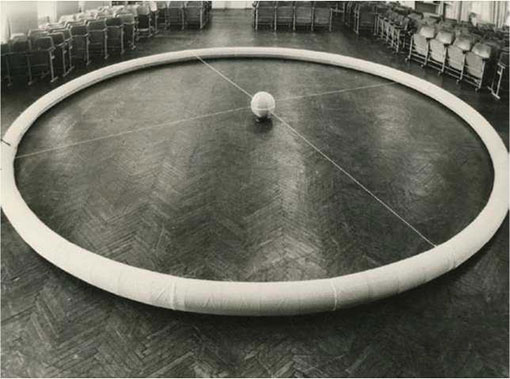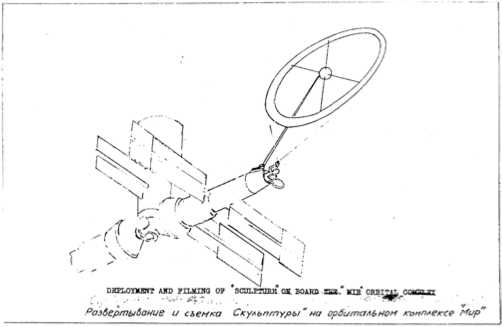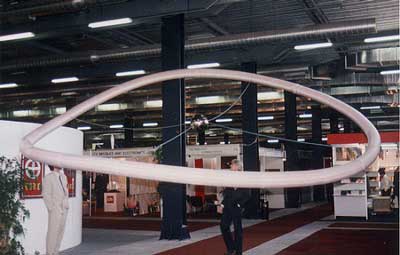The OUR-Space Peace Sculpture Project
Introducing a Cultural Dimension into the Space Environment
Arthur R. Woods – Artist, Founder and President of the OURS Project. Member: I.A.A.A., I.S.A.S.T.
Marco C. Bernasconi – OURS Vice President – Technical, Member: FBIS, A.I.A.A.
Paper IAA-89-673 Presented at the 40th Congress of the International Astronautical Federation
October 7-13, 1989 / Torremolinos, Spain
Abstract
Recent developments concerning the commercial use of outer space have made it possible for cultural events to take place in the space environment which can be seen and experienced by much of the world’s population. The opportunity to communicate to the global audience as well as to add a cultural dimension to the development of outer space may have much bearing on how space exploration and development are perceived by the people of our planet. Therefore, the first of these “cultural space events” may set a precedent for any further uses of space technology for this form of global communication. This paper deals with the realization process of a space art work dedicated to humanitarian goals which may soon become the “first” art work to be released into the space environment, as it is being implemented under the leadership of the OURS Project.
The OURS – Orbiting Unification Ring Satellite Project is an internationally-oriented cultural organization with the goal to place a visible symbol of planetary unity, wholeness and peace in Earth orbit during the year 2000. As a first step to the realization of this goal, the OURS organization is developing the near term project to deploy from manned vehicles two space sculptures designed as symbols of and calls for global peace during the 1992 International Space Year. For the realization of these – the Orbiting Unification Ring – Space Peace Sculptures (OUR-SPS) – a program of international participation and support consisting of individuals, artists, businesses and organizations, is being created. This cultural and innovative use of space technology has involved the participation of people in more than 15 countries, with the spacecraft’s first flight already booked with the Soviet commercial agency, Glavcosmos.
The paper summarizes the gestation of the project, describes the technical specifications of the sculptures and their environmental impact, discusses its organizational setup and outlines the planned mission operations.
1. INTRODUCTION
1.1 Star Wars or Star Peace?
As the year 2000 draws nearer, humankind is becoming increasingly conscious of its place in the universe and of the Earth as a living entity. There is a growing awareness of the interdependence of the human family and the interrelationship of all life. Our communications, our economies, our politics as well as our problems have become global processes. We now know that it would be technically possible to eradicate most diseases, to overcome hunger, to reduce pollution and to eliminate nuclear weapons, if these issues could be addressed from a planetary perspective. Furthermore, our species has been creating new technologies to explore and develop the immensity of outer space. Thus, though we may now find ourselves on the threshold of the greatest age in human history, we know that we are still a danger to ourselves and to all life on our planet. It is a challenge of our time to find new ways of working together that transcend our personal interests and our differences. It is our responsibility to our planet and to our future generations to find and explore ways which will contribute to solving our global problems in order to insure the success, the survival and the future of all life on Earth.
Our species is at war with the planet. Today, over 100 million people are employed in the defense industries of the world. More than 26 million people live in countries with armed conflict. More than 200,000 children under the age of 15 carry weapons. The greatest threat to human survival and indeed to the survival of all life on our planet is the 50.000 nuclear weapons – most of which are sitting atop space borne delivery systems. The signing of the Intermediate Range Nuclear Forces (INF) Treaty in December of 1987 signaled to rest of the world that the superpowers were ready to take the first steps toward peaceful co-existence. Six months later, when the U.S. Congress ratified the agreement, more nuclear weapons had been built by both superpowers than will be destroyed in the three years stipulated in the agreement. Global military spending (not just on space) increased from $1.6 million dollars a minute in 1986 to $1.7 million in 1987, and to $1.9 million in 1988 (Tages-Anzeiger, 1986, 1988). Unfortunately, third world countries have begun to invest needed resources in their own missile weapons systems and this missile proliferation is occurring at a time when many of these same countries are proceeding with the development of chemical and nuclear weapons programs. Between now and the year 2000 over 60 countries – including Libya, India. Pakistan and South Africa – will have the technological know how to build and deploy nuclear weapons. The danger being the higher potential for accidental launch and less political and military restraint for using these weapons (ACDA Report – 1988, Aviation Week, August 28, 1989). With the odds for nuclear and chemical war ever increasing, the survival of humanity and Earth itself – is at stake.
The desecration of the biosphere has become public issue number one. Population pressures, ecological imbalance, endangered species, persistent world hunger, terrorism, drug use, continued disparity among the rich and the poor nations and a moral disintegration in our developed societies are all indications that humankind is not at peace.
The development and exploration of space offers one the best hopes to help correct this situation. If properly pursed this activity could relieve many of these pressures and contribute substantially to alternative approaches to managing our planet. As space development has been intimately linked to military strategies, and even though space technology represents the highest expression of our species’ technological achievement, the case (or its contribution to the wellbeing of our planet cannot be divorced from the concerns and (ears of technology held by the general public. Also, as space exploration and development have essentially been the domain of governments, there has been very little opportunity for personal involvement by the average public which has been mostly only a spectator. Even the Apollo Moon landing and the fascinating exploration of the solar system have not stimulated a unanimous and universal support for this important human activity.
But space technology does provide an option of choice to monitor the state of the biosphere, leading to an improved understanding of environmental change and its consequences. Moving some of our most polluting industries into space or replacing them with space based alternatives could have a marked effect on improving the quality of the environment.
Politically, space activities have and will continue to foster and stimulate international cooperation. The European Space Agency represents the peaceful space interests of thirteen participating nations. Nations are beginning to realize that the high cost of space activities may be offset through cooperation. We are coming to the understanding that, seen from space, there are no political boundaries on Earth. Such developments are contributing to a lessening of political tensions on our planet and are enhancing our species’ chances for avoiding the consequences of a nuclear exchange.
Satellite communications have enabled us to have instant access to world events and have stimulated the global transmission of information and culture. The high standards and quality of space hardware and software have led to technological innovation in many areas of industrial production resulting in a profound impact on the world economy which relies on space technology for the exchange of information.
The image of the whole Earth as seen from space has given us a sense of our interdependence and inter-connectedness to each other and of the ecological unity of all life on Earth, and this “The Overview Effect’ (White, 1987) is permeating our global consciousness in many ways. Research into micro-cosmos has paralleled the investigations into the macro-cosmos and together, this information is giving us a new perspective on the nature of matter and the evolution of the cosmos.
These activities will continue to provide new ideas and will contribute to the creation of more complex systems of awareness. If successful, they will one day lead to the establishment of space colonies and perhaps even future civilizations independent of Earth and, as important; they will further enhance our understanding of our place and purpose in the universe. The philosophical implications of space activities illuminate the essential role and importance that humankind and life, as we know it on Earth, may have in the overall evolution of the universe.
Thus, it appears that the advent of our species’ capability to explore and develop the immensity of outer space is a signal that it and life itself may have arrived at a moment of conscious evolution – the possibility for life to evolve beyond our planet. It appears that space technology today is here and ready to be used for either of two purposes: to be used to eradicate all life on our planet or to be used to take the seed of life from Earth and to plant it in other places. If the latter path is taken, it may enable life from Earth to become forever un-killable – an immortal and essential part of the universe.
Perhaps other civilizations on other planets have had to make a similar choice. Now here on Earth, it is up to those of us alive today, especially those of us involved in space matters, to make this ultimate and essentially cosmic choice.
1.2 The Role of Art in the Space Environment.
In 1911, Wassily Kandinsky wrote: “The great epoch of the Spiritual which is already beginning, or, in embryonic form, began already yesterday……provides and will provide the soil in which a kind of monumental work of art must come to fruition.” (LACMA, 1986)
“The artist and the community are profoundly interrelated. Traditionally, artists have been channels for the tempo, the tone and the intensity of their society. The function of their art is to express feeling and transmit understanding. In a genuine work of art one recognizes what is being shared by our common humanity. Artists achieve this through an intuitive appreciation of the appropriate form and through the use of materials made available to them by the circumstances of their time.”
The British art historian Herbert Read wrote the above words and also these: “art is a direct measure of humankind’s spiritual vision. The great monuments of the past were celebrations of a communal vision which was closely bound up with some form of religion. Religions created myths to explain their perceptions of the universe and art served to convey these myths.” (Read, 1967). Over the past centuries this bound has been getting looser and today, though we live in a time of great wealth and technological marvel, our century has yet to produce a contemporary monument to the human spirit comparable to those of the past.
Since the beginning of our civilization and perhaps since the advent of human consciousness, the artist and the scientist have been partners in the task of communicating our understandings of the nature of the universe. It has often been stated that the scientist and the artist are very similar, especially in their approach to exploring and investigating their particular subject matter. In earlier times the scientist and the artist were often one and the same person – Leonardo da Vinci being the most obvious example.
Today, the complexity of current society has led to increased specialization which in turn, appears to have contributed to a lack of mutual appreciation and understanding between the arts and the sciences. The sheer volume of information available today augments this situation. Furthermore, the fear of the environmental consequences associated with technology used for weapons development, power production, genetic manipulation, chemicals, and information control (to name but a few areas of concern) have created a widespread mistrust for advance technology among the general public. Artists have in turn, expressed and included these fears in their works, or reacted by avoiding or confronting this situation by pursuing avenues of artistic semantics understandable mostly to their peers and critics.
Interestingly, though it may have been the early works of science fiction and the descriptions and depictions of the cosmos by artists of a hundred years ago that stimulated the first space pioneers, art since, has played only a very minor role in the development of the space environment – serving mostly in an illustrative and documentative capacity. Likewise, very little of today’s mainstream art has much to do with human activities in space. If space exploration and development are to ever be truly successful and universal, this situation will need to be rectified.
Recent developments in the commercial use of outer space have now made it possible for cultural events and objects to enter this environment which can be seen and experienced by much of the world’s population. Art works that may be simultaneously experienced by the entire planet represent a revolutionary development in the history of the visual arts. But access to the world audience via space technology is more than just a unique opportunity for the creation of globally experienced art works. The first art works in space designed to be visible to the world’s population will almost invariably be symbolic and will attempt to communicate universally understood values and understandings. They may also be opportunities to link space activities with the future wellbeing of our planet as well as opportunities to include the participation of a large international public in their realization.
Furthermore, as art “knows no boundaries”, art works in space may contribute to more international understanding through the simultaneous and global sharing of these unique cultural events. They may contribute to international cooperation through the necessary involvement of various governmental agencies. They will require the collaboration of scientists, engineers and artists, once again working together in mutual understanding and respect of each other, on another level, the cost and complexity of bringing these works to completion will involve the participation of the industrial and the financial community. When that participation involves the military industrial complex, they may have a transforming influence on some of our technologies, finding new areas of application, or at the least, becoming a new customer for the talents of these industries. And finally, their eventual realization will be a driver to future cultural experiments in this environment – a stimulant to future visionary creative thinking.
If the advent of space exploration and development is truly a signal that our species and life itself is about to make an evolutionary jump of cosmic proportions, then an art of comparable significance will be an essential ingredient to its success. The time has come to put our whole culture into space by adding a cultural dimension to our extra-terrestrial vision and art to its development. This art will invariably be global, monumental, visionary, and will use space itself as a new medium of expression (Woods, 1987).
2. OURS FOR THE YEAR 2000.
2.1 A Global and Collective Art Work In Space.
Although this paper concerns a near term project designed for the year 1992, some mention must be given to the origins of the OURS Project as background.
In 1984, the OURS Project was launched with the goal to celebrate our species’ passage into the next millennium with a “circle in the sky” symbolizing planetary unity, wholeness and peace. This circle would be the result of an orbiting reflective sculpture called the Orbiting Unification Ring Satellite or OURS. Embodied in its name “OURS” was the concept that this art work would “belong” to the entire planet and as such, it was conceived of as a global and collective project that would be dedicated to helping create a better, safer and healthier planet for Earth’s present and future children.
As it is presently conceived, the OURS will be an enormous space sculpture in the form of a continuous ring with a diameter of more than one kilometer. Its mirror-like surface will be painted or decorated by artists’ expressions representing every nation and culture on our planet. In its center will be an archive containing a record of artworks, messages and signatures of everyone who participated in its realization and perhaps some other forms of cultural significance. Its ultimate design will be the result of a global, collaboration of artists, scientists and engineers. In the year 2000, this globally created monument is to be placed into orbit around our planet and illuminated by sunlight, it would appear as a circle or an ellipse in the sky -visible with unaided vision, to everyone on Earth. {Figure 1) Utilizing a deployable solar sail, at a pre-designated time the OURS will suddenly become a brilliant star that will slowly disappear from our skies as it leaves Earth orbit, propelled by the pressure of sunlight, to travel and to remain in space forever as a gift from our time to our future generations.
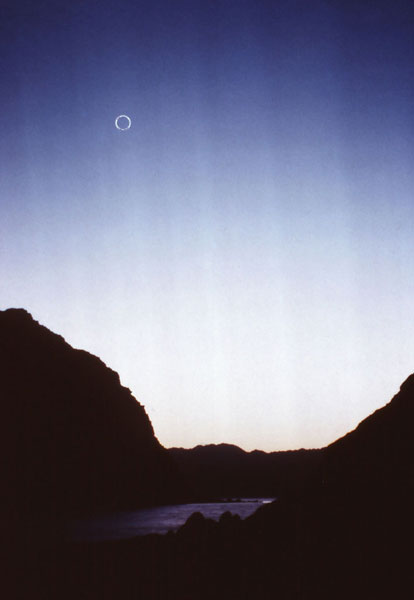
Figure 1. A Circle in the Sky for the year 2000.
2.2 Technical Possibilities of the OURS.
To fulfill these requirements three possible configurations have so far been suggested. (Bernasconi, 1988) They consist of: 1) a truss work as a structural backbone configuration, 2) a centrifugally stabilized solar sail ring, and 3) a rigidized inflatable toroidal ring. Environmental concerns in relation to mass efficiency and visibility have favored the toroidal ring configuration.
As a reference configuration, such an OURS structure would have the following dimensions:
Diameter – 1 km
Slenderness Ratio – 100
Area/mass Ratio – 0.2 kg/m2
Constructed out of space rigidizable membrane (discussed in Section 3.5) with a metallic coating, this OURS configuration would weigh approximately 20.000 kilograms with an overall area mass ratio of approx. 0.64 kg/m2. A sculpture utilizing this technology could be packaged into the payload area of a typical launch vehicle capable of transporting this mass into orbit. Deployed by inflation, the wall of the sculpture would harden in the presence of sunlight and the expandable structure would become a structurally stable entity. (Figure 2.) Placed in a high inclination orbit, such an OURS would be visible to the entire population of the planet as a circle or an ellipse. At an assumed distance of 500 km the image will be approximately one – quarter the size of the Moon. Visibility would occur approximately 10 minutes before sunrise and after sunset. (Stenflo, 1986) Calculations indicate an angular extension of 2 mrad which would provide a peak magnitude between -7 and -20 – the toroidal configuration reflecting sunlight in a diffuse manner. For an extended duration in orbit and for the deployment of the solar sail, an orbital altitude higher that 750 km will be chosen.
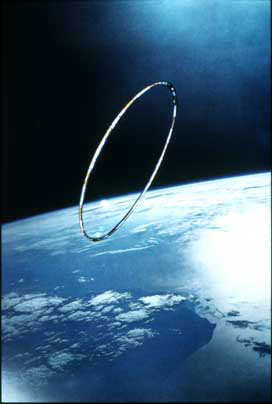
Figure 2. The OURS as an inflatable toroidal ring.
In deference to the criticisms raised recently by astronomers to orbiting art works in space, the OURS project does not wish to create the brightest object in the sky. Rather our objective is met when the OURS is easily recognizable to the naked eye as its symbolic form. This topic is dealt with later in Section 4 pertaining to environmental considerations.
The ultimate design, choice of technology, operating characteristics and decoration of the OURS is being deliberately left open at this stage and will be the result of prior testing and experimentation.
This will be carried out on Earth and in the space environment through the realization of a series of smaller sculptures, the first being readied for 1992. The costs of their realization will be sustained by private funding derived from a global participation plan involving people, businesses and organizations from every nation.
3. OUR – SPACE PEACE SCULPTURES – 1992
3.1 Peace off Earth, Peace on Earth, Peace with Earth.
Humankind has attached its highest ideals to the development of space, and the concept of “peace” has had an integral association with space activities. When the Apollo astronauts stepped onto the Moon, they placed a plaque upon which were inscribed these words: “We came in peace for all mankind “. The Russian word for peace is the word “Mir” which is the name given to the Soviet Unions manned space station currently circling the planet. The charter of the European Space Agency reads: “The purpose of the agency shall be to provide for and to promote for exclusively peaceful purposes,
cooperation among European states in space research and technology.” The first clause of the “Magna Charta of Outer Space for All Nations” states: “Outer space is the Key to world peace.” (Finch. 1984).
As the introduction of a cultural dimension into the space environment will be a significant event in the history of space development as well as in the history of art, it should celebrate this hope for world peace which is the promise of space. In this spirit, the OURS of the year 2000 will be preceded by one or several smaller sculptures that will have the concept and the message of peace – “Peace on Earth and Peace with Earth” embodied into every aspect of their form and realization. Their purpose and message will be obvious and universal to all who encounter them. They will celebrate and focus attention to the peaceful development of outer space and the opportunity that this activity offers the nations of our planet. Their realization in space before a global audience will cause the concept of “peace” and all that this word means, to be simultaneously experienced by the people of our planet. Called OUR – Space Peace sculptures (OUR-SPS), they are being readied for deployment during 1992 – the International Space Year.
3.2 The Symbolic Form of the OUR – SPS.
Symbols are very powerful means of communication which work on the sub-conscious level, often going unnoticed by the conscious mind. Their power to communicate has been recognized since the beginning of human consciousness. Throughout the ages our understandings of nature and the cosmos have been integrated into the ancient and universal form of the circle, endowing it with symbolic power to express the idea of unity and wholeness. The circle is to be the symbolic form of the OURS being defined for the year 2000.
The form of the OUR-Space Peace Sculptures will be a circle divided by a cross in the center and this form, like the circle configuration of the OURS, is also an ancient and universal symbol. (Figure 3.)
This exact sign is the Greek symbol of the planet Earth. It is also the main ceremonial and sacred symbol of the American Indians – the medicine wheel, as well as the basis for their geometry and architecture. In the Mayan culture this symbol is called “Kalumetl” with the circle representing the concept of “eternity”, the cross in the middle indicating the direction of the four winds and the point of intersection being the place where peace resides. In alchemy, the symbol represents the element gold meaning “inner gold” and a higher state of consciousness. Variations of this symbolic form can be found in many cultures with similar meanings. To further emphasize their symbolic meaning, the word “peace” expressed in the languages of the world, is to be painted on the surface of the sculptures. In this way, the universal message of the OUR-Space Peace Sculptures are embodied and imbued in their symbolic form.

Figure 3. The symbolic form of the OUR-SPS
Two cables connected equidistantly along the sculpture will divide the circle into quadrants. Suspended in the center, will be a sphere – representing a miniature Earth. Contained in this sphere will be a laser disk record of all the art works, messages and signatures contributed by those who participated in making the sculptures possible. Their deployment in space will be televised to the world audience and this will be coordinated with activities around the globe such as concerts and theater events. Thus, as an idea, a process, an event as well as an art work, these “rings of peace” will circle our planet and their message will become known to the world.
3.3 The Concept of the OUR-SPS.
As the cost of space transport has much to do with the weight of the payload and the fact that symbolic visibly recognizable space artworks would necessarily be large and complex objects, a concept was developed for the OUR-SPS that would deliver much impact for a modest price. The concept also tries to avoid the problem of creating astronomical interference as well as contributing to the problem of space debris.
The concept for the OUR-SPS is in effect that of a mini satellite – a sculpture weighing less than 10 kg that could be packaged into a small container and sent into space through normal commercial channels with the project assuming all the costs for its development and transportation. The only requirement being that its deployment shall occur in 1992 and that this deployment be televised from space to the world audience. This aspect requires the participation of a cosmonaut or an astronaut, and thus adding a human involvement to the event. It also narrowed the flight possibilities of the OUR-SPS to either the U.S. or the U.S.S.R. (Figure 4.) To keep the event as international as possible it was determined that, if possible, the sculpture would be manufactured in a country other than the one that deployed it.
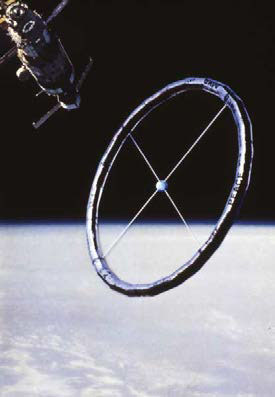
Figure 4. The OUR-SPS deployment from the Mir space station.
3.4 Flight Proposals for the OUR-SPS.
In 1985 information sent to the OURS project by NASA indicated the existence of a Non-Scientific Payload Program specifically set up to deal with payloads of a non-scientific nature. In the summer of 1987 it was announced that the Soviet space program would begin offering its services on a commercial basis through a special agency called Glavcosmos.
On the January 13, 1988, identical proposals were sent to these agencies of the U.S. and the U.S.S.R. requesting the transport and deployment of the OUR – SPS with the OURS Project assuming all the costs for this service. To avoid any references of propaganda it is important that the sculptures be privately financed.
On February 25, 1988, at Space Commerce’88 taking place in Montreux, Switzerland, a “Letter of Intent” was signed between the OURS project, Glavcosmos and its commercial agent V/O Licensintorg. The text of the agreement reads: “OURS and Glavcosmos mutually agree to cooperate in the realization of an OUR-Space Peace Sculpture as a symbol of world peace”. The actual Launch Agreement is presently in the final stages of negotiation with signing expected to take place before the end of 1989. (Figure 5.)
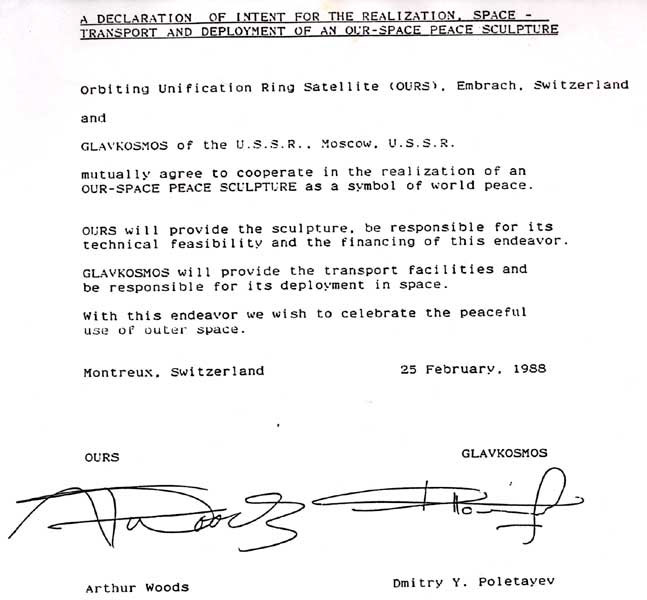
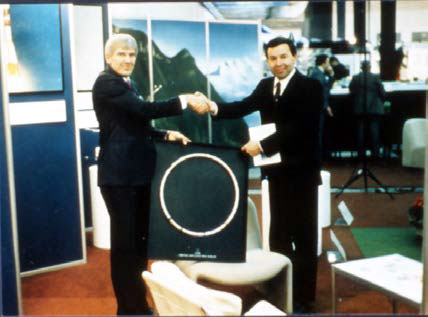
Figure 5. Signing the agreement with Glavkosmos Space Commerce, Montreux 1988..
The maximum dimensions for the sculpture’s container necessary for a deployment from the Mir space station are: 320 mm in diameter and a length of 510 mm. (Figure 6.) These maximum dimensions enable the payload container to pass through the air lock of the Mir station. It was agreed that the OURS project would pay the going commercial rate of $15,000 per kg charged for experiments flown on the Mir. With a payload estimated to weigh approximately 10 kg the total cost of the transport and deployment has been set at 210,000 Swiss Francs – approx. $150,000.
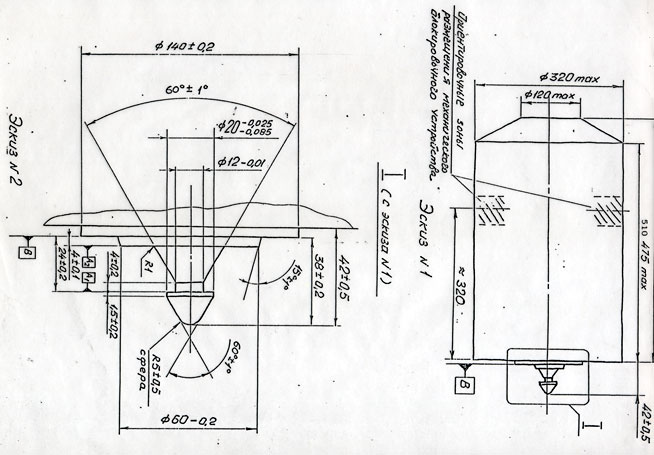
Figure 6. OUR-SPS payload container for the Mir station.
Perhaps due to the fact that the space shuttle was at that time grounded because of the Challenger accident, no answer was ever received from NASA to the same proposal. One art work was flown under this program recently, but the Non-Scientific Payload program has been rescinded.
With the resumption of the space shuttle flights, contact was taken with NASA again in 1989 concerning the possibility to fly the OUR-SPS as a Get Away Special (GAS) payload. At a meeting held at NASA Headquarters on May 31. 1989. NASA officials indicated that the reservations for this type of deployment are at the moment frozen and if GAS deployments were once again available, the OUR-SPS would have to be justified on a scientific basis and would have to find a sponsor in one of the NASA departments.
The OURS project has since referred its proposal to the National Space Council (NSC) with a letter mailed on July 25, 1989 suggesting that the OUR-SPS become a cultural addition to the proposed “Mission To Planet Earth” program and asking simply for the endorsement of the NSC. At the time of this writing, no reply has been received.
The members of the OURS project remain optimistic and believe that the United States will eventually also agree to transport, deploy and televise an OUR-SPS in 1992. The apparent reluctance of the U.S. space program to deal with our proposal probably has much to do with the fact that, in space matters, culture and art continue to have a very low priority.
3.5 The Technical Design of the OUR-SPS.
It is important that the OUR-SPS be manufactured in state-of-the-art space technology. Consideration of future applications, safety factors, price, payload weight and the opportunity to involve the active participation of the aerospace industry in their development are considered to be the determining factors.
As an inflatable space technology appeared to be the most satisfactory solution for these requirements, Requests for Proposals (RFP) were sent to firms that possessed the technical knowhow. One proposal was received from the firm Contraves AG located in Zurich, Switzerland. A second proposal has been made by Glavcosmos in the course of negotiations.
ISRS – Inflatable, Space Rigidized Structures is the name of a technology for large expandable space structures that has been under development for ten years by Contraves under a series of contracts as a part of ESA’s technology program. The ISRS technology consists of a thin, fiber-reinforced composite lamina which creates an inflatable type structure. This structure is assembled and launched in a pre-impregnated state to enable its folding and storage in the transportation vehicle and its deployment to its operational shape when in orbit. There, once inflated and activated by solar radiation, a chemical reaction hardens the matrix around the fibers, yielding a cured composite lamina with new physical properties suited to the structure’s operational needs (Bernasconi, Seiz and Reibaldi, 1984). This technology appears very suitable for large structures in space and foreseen applications include antennas, equipment shields, enclosures, beams, concentrators, shelters, solar sails and hopefully, space sculptures (Bernasconi and Reibaldi, 1985) (Bernasconi, Pagana and Reibaldi. 1987) (Bernasconi and Kose, 1988).
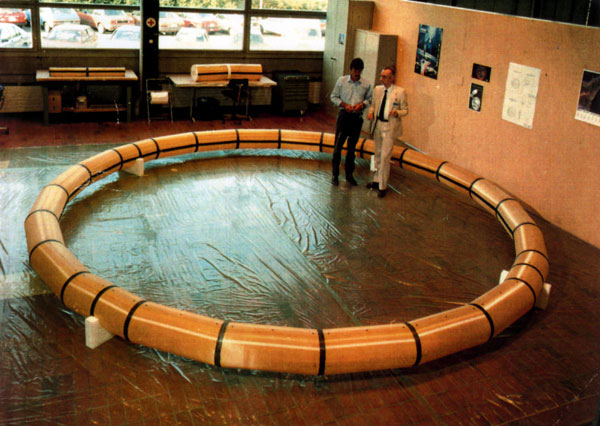
Figure 7. An ISRS Torus at Contraves AG, Zurich, Switzerland
Of particular importance to the OUR-SPS concept were three particular aspects of ISRS technology. First, the fact that such toroidal structural elements have already been built and tested at Contraves. The torus pictured in Figure 7 measures 5.6 m in diameter, has a ring thickness of .32 m and weighs approximately 2.5kg. Second, inflatable and rigidizable structure technology, especially in relation to solar-sail applications, is important to the next generation of OURS space sculptures. And third, a rigidized structure minimizes potential break-up and fragmentation and as such, reduces the chances of it becoming a source of space debris.
The Contraves proposal suggests a 6-10 m deployable polygonal toroid with a metallic coating to achieve good light reflectivity. Attached to it, four strands, disposed orthogonally in its plane, support a small module, the Archive, which is located at the very center of the sculpture. Seen from a direction normal to its plane, its shape depicts of the astronomical symbol of its planet of origin and destination: Earth.
The following are the provisionally assessed mass budget figures.
OUR-SPS Torus – 3 kg Relief Valves – 0.8 kg
Container Structure – 3 kg
Release Mechanism – 1.2 kg
Miscellaneous Elements – 1 kg Archive – 1 kg
Total Payload Mass -10 kg
The sculpture will be folded and packaged into a protective container that meets the size requirements of the air lock of the Mir station. Jettisoned from the air lock of the Mir station at a speed of 2.3 m/sec, deployment will occur at approximately 10 m distance. A timing device will activate a release mechanism that will enable the sculpture to emerge, unfold and deploy into its pre-determined configuration. From a view port parallel to the air lock or by a cosmonaut during a spacewalk, a film or video record of the deployment will be made. This documentation will be then transmitted from space and broadcast to the world audience. The images of the OUR-SPS in space should include the Earth in the background.
In the course of negotiations concerning the Launch Agreement, Glavcosmos officials indicated that they had the technical know how to build the OUR-SPS and offered a “Turn Key” proposal.
A continuous toroidal ring with a diameter of 6m and a ring thickness of 0.15m would be deployed by inflation. Its center area could be spanned with either a transparent membrane or a cable construction as required to suspend the sphere archive in the center. The spheroid archive would be up to 0.5m in diameter.
The sculpture would be delivered to the Mir station and would be deployed with the active participation of a cosmonaut. This cosmonaut would jettison the sculpture by hand into space. A second cosmonaut would videotape and/or film this event which then be transmitted from space and broadcast to the world audience.
Knowing in advance the orbit of the Mir station, it should be possible to actually see the OUR-SPS as it would resemble a small moving star. Due to its very low mass, in a matter of a few days atmospheric drag would cause the entire sculpture to be totally consumed by fire in the Earth’s atmosphere leaving behind no space debris. The development, construction, testing and delivery of the OUR-SPS as well as its cost, will be managed in three phases as per normal aerospace practice. The costs for Phase B will be established at the end of Phase A and likewise, the cost for Phase C/D upon completion of Phase B.
The estimated costs are:
Phase A: Technical Feasibility study -$50,000
Phase B: Technical Definition -$150,000 – $200,000
Phase C/D: Development and Manufacturing -$400,000 – $750,000
Transport and Deployment -$150,000
Total Estimated Costs -$750,000 – $1,100,000
3.6 An OUR-SPS Deployment from the U.S. Orbiter.
The OUR-SPS payload designed for a Mir deployment can be adapted to a Get Away Special (GAS) canister that is a part of NASA’s Space Transportation System. Some development costs may be saved from the experience of designing the OUR-SPS system for the Mir, but stringent safety requirements and testing would most likely result in an equally (in)expensive second OUR-SPS designed for the U.S. orbiter.
The GAS (Get Away Special) program was initiated in order that individuals and organizations, both public and private, of all countries would have the opportunity to send scientific research and development experiments of their own choosing into space aboard NASA’s space shuttle orbiter (NASA, GAS Handbook 1987).
The price for GAS canisters is based on volume required and experiment weight. For the OUR-SPS a canister measuring 49.6 cm in diameter and 71.6 cm in length with a volume of .14 m3 and a maximum weight allowance of 90.7 kg would be chosen. Fitted with an opening lid option the price of the canister would be approximately $25,000.
The experiments must comply with NASA’s standards such as safety and peacefulness. The GAS experiments are flown on a space available basis and a rotating queue has been set up for three major categories: educational (Class I): foreign and commercial (Class II); and Government (Class III).
Unfortunately, new reservations are not being accepted at this time but NASA officials connected to the GAS program have indicated that they hope the reservation list will be reopened. It may be possible for the OURS to purchase a GAS reservation from one of the present owners. This is an option if no other opportunity is available and NASA officials have supplied the OURS Project with an owner s list of GAS canisters. Another option would be to have the OUR-SPS manifested as a secondary payload. This would be a time and cost intensive solution. Needless to say, a deployment of an OUR-SPS from the open bay of the space shuttle orbiter would be spectacular.
The manufacturing and deployment cost for an OUR-SPS deployed by the U.S. is estimated to be:
GAS canister -$25,000 OUR-SPS2 -$650,000-$950.000
Estimated Total Cost of U.S. Deployment: $675,000-$975,000.
4. ENVIRONMENTAL CONSIDERATIONS OF VISIBLE SPACE OBJECTS
4.1 Points of Consideration.
Visible space objects offer an unprecedented access to the global audience and such opportunities do not go by unnoticed. Proposals have already been put forth to use this opportunity for the promotion of commercial and nationalistic interests. Objections have been raised by the astronomical community as these objects may interfere with celestial observations. Others have expressed concern that using the night sky for advertising would be an infringement on our already spoiled environment. Furthermore, after more than 30 years of space activities, space debris has become the first human generated environmental problem in outer space. Thus, due to the novelty and the publicity surrounding the first cultural expressions to take place in the space environment, these art works will most likely be subject to a more stringent environmental and ethical scrutiny than is normally applied to other objects place in orbit.
Since its inception, the OURS Project, aware of the above mentioned considerations, has tried to incorporate both ethical and environmental responsibility into its space sculpture designs. The project’s approach has been to make the realization of the sculptures as acceptable to as large a public as possible and to make the sculptures themselves, as environmentally benign as possible. These considerations are being applied to both the OURS being proposed for the year 2000 as well as to the smaller OUR-SPS being readied for 1992.
4.2 Space Debris.
Mendell and Kessler, (1986) point out: “In the popular view, “space” is both empty and infinite, yet Low Earth Orbit (LEO) is neither”. Currently there are approximately 7,000 trackable objects (10 cm or larger) circling the planet, of which only 5% are operational payloads. The other 95% are considered as “space debris’, most of which is generated by the fragmentation of satellites and spent upper stages of launchers. A critical density has been defined and it has been predicted that a 20% increase in LEO space activity will see this critical density reached in the year 2016 when the number of detectable objects orbiting the planet at 500 km will number more than 260.000. An evolution of space transportation systems may modify the rate of growth of orbital debris, but the presence of human crews in space makes the problem even more acute as the ever increasing probability of a life threatening impact situation occurs long before the critical density is reached. Even smaller particles pose a threat to any extra-vehicular activity undertaken by astronauts and cosmonauts in spacesuits. The space community is studying this problem and direct and indirect measures are being considered. Obviously, finding a solution to this problem may be central to the whole future of space development.”
The OUR-SPS should not add to the problem of space debris for several reasons. Due to the fact that the mass of the sculpture is very low in relation to its surface area and that deployment in LEO will occur at an orbital altitude of 400-450 km in the case of the Mir, or at 200 to 500 Km from the U.S. orbiter, atmospheric drag will cause the orbit of the sculpture to decay rapidly. Within a matter of a few days the sculpture will enter the denser upper atmosphere and will totally burn up. Glavcosmos officials have stated that orbital decay could be accelerated by deploying the sculpture directly toward the Earth. An OUR-SPS deployed by the U.S. would react similarly or it could be retrieved and returned to Earth on the same flight.
An advantage of the OUR-SPS design is that the rigidizable material gives the OUR-SPS structural stability which will minimize its break-up and fragmentation upon re-entry. Likewise, impact by a meteoroid or other object during its short lifetime would only result in a corresponding sized hole in the sculpture. If deemed necessary, it would also be possible to have the payload container remain attached to the sculpture by a tether insuring that it, too, would quickly leave LEO. This matter will be taken up in the Technical Design Study.
The use of rigidizable technology for the OURS of the year 2000 would give it the same advantages concerning break up and impact. Of further importance, is the question of control in orbit. The OURS will have control mechanisms built into its design which can be controlled by on board computers or by signals relayed from Earth. Integrating a deployable solar sail into its design and having the sculpture leave orbit as planned, avoids this problem altogether, and this is the project’s current approach. The OURS Project invites further suggestions from the scientific community in this matter.
4.3 Interference of Astronomical Observations.
Already hampered with light pollution generated by electrical illumination of large populated areas, astronomers have complained that the introduction of large, very bright objects would further interfere with Earth based observations. Also, they have expressed concern that the intensity of the light reflected by these objects may be strong enough to damage their sensitive instruments. Such criticisms were instrumental in the cancellation of a visible space sculpture project intended to celebrate the 100th anniversary of the Eiffel Tower in 1989.
With a predictable decaying orbit lasting only a few days, the OUR-SPS should not be a cause of concern to the astronomical community. With a maximum crown diameter of 10m and slenderness ratio of 50, one can estimate a magnitude of less than -0.50, which is almost insignificant. Like the OURS of the year 2000, it too will have a time window of visibility of just 10 minutes and an orbital period of approximately 92 minutes.
As it relates to the OURS being proposed for the year 2000, astronomers will have to contend with many visible objects in Earth orbit in the coming years – including orbiting astronautical facilities. Some astronomers, aware of the advances in space structures technology, have proposed telescopes called “Vast Orbiting Reflectors” (VOR) with diameters of 100m to 1000m that, coincidentally would utilize technologies similar to the OURS sculptures (Taylor, 1986). These telescopes would seem to be visible to ground observers and would be a source of interference to their ground based colleagues. The OURS sculptures could contribute to the advance of astronomy in the design of such astronautical facilities, if cooperation can be established and maintained. The project invites any suggestions in this area and will actively seek cooperation with the astronomical community wherever possible.
4.4 Advertising in Space.
Another issue raised concerning space art that can be seen from Earth, is the potential that these objects will be used for advertising purposes. The proposed “Eiffel Tower in Space” was promoted by a private company – the New Society for the Eiffel Tower. Being a symbol of Paris and France, an “Eiffel Tower in Space” would have been a global advertisement for this Parisian artifact as well as for the bi-centennial celebration of the French Revolution. Glavcosmos will accept advertisements on the sides of their rockets, at their launch facilities, on their cosmonauts and will do video advertisements in and from the Mir station. Recent agreements have been signed with advertising agencies and televisions stations to send privately sponsored cosmonauts onto the Mir. NASA has had a consistent policy refusing such commercial use of its services.
The high cost and technical complexity of visible space objects will keep their number to a minimum in the immediate years ahead. The risk of unpopular expensive advertising in our increasingly environmentally conscious society may be a stronger limiting factor of “sky ads” for the moment.
The OURS sculptures will not have any advertising purpose. They will be purely symbolic and artistic works. The OURS project is neither a commercial venture nor an expression of corporate or national identity and it is hoped that the first sculptures will help set the proper precedent for such cultural activities in space. On the other hand, the OURS Project recognizes the need to put our whole culture into space for space development to be successful and maintains that corporate exposure to this environment, if tastefully and responsibly pursued, can be a good thing.
5. PUBLIC PARTICIPATION AND FUNDRAISING.
5.1 “Belonging to Us”.
The word OURS means “belonging to us” and the goal of the OURS project is to share the creation and the realization of the sculptures with as many people as possible. The project is pursuing a plan that includes the active participation of individuals, businesses and organizations.
5.2 A Piece of the Ring.
One popular way of creating and sharing this global artwork has been the “Public Painting ‘ activity begun in 1987. During exhibitions, the public is invited to paint on large segments of metallic foil (Mylar™) similar to the material which is to be used for the construction of the actual satellites. This communally produced painting is then randomly cut-up into “Pieces of the Ring” measuring 10cm x 10cm. A “Piece of the Ring” and a Certificate of Participation are given to everyone who supports the project. This activity is a way for anyone, without cost, to add their energy to the project’s success. It is also symbolic at this early stage in the project’s development of the global art work being proposed for the year 2000. (Figure 8.)
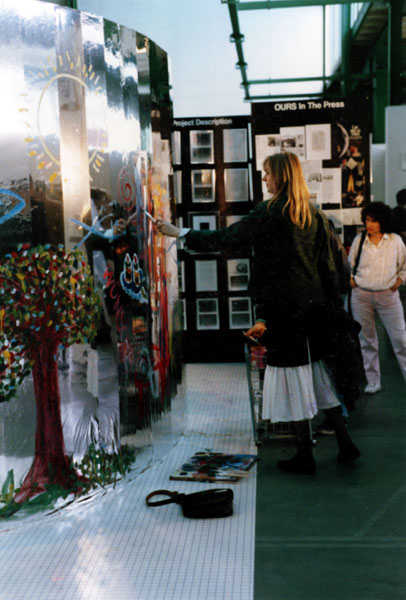
Figure 8. OURS installation and public painting activity at the Art 18 Basel art fair, 1987.
Anyone can become a supporter or a member of the OURS project. For a membership fee of 50 Swiss Francs or $35 international, members receive a yearly “Piece of the Ring” and project updates via OURSWORLD – the project newsletter. Any contribution the furthers the project is being accepted and a signature, message and/or art work from each supporter or member will be scanned on to a laser disk which will be placed in the archive of the OUR-SPS when it is sent into space. To date, people in more than 20 countries have contributed to the project.
5.3 The OURS Artists.
From its inception, the OURS project was conceived to be a global and collective artwork and the project has taken the first steps to integrate worldwide artistic participation in the realization of the sculptures. Since 1987, children from many countries have been making drawings for the project and since 1988, artists have been invited to join the project with their art made for or about the OURS (Figure 9.). These works are being displayed in local and international exhibitions of the project. With specific agreements with the artists, their art is being sold to help raise funds for the project. This is being done in a mutually beneficial way in which the artists receive a payment for their art that is sold. As the OURS project is about the realization of global art works and not, as some people mistakenly assume, a charitable activity, one of the most important means of funding the project will be the sale of the art works made by the OURS Artists.
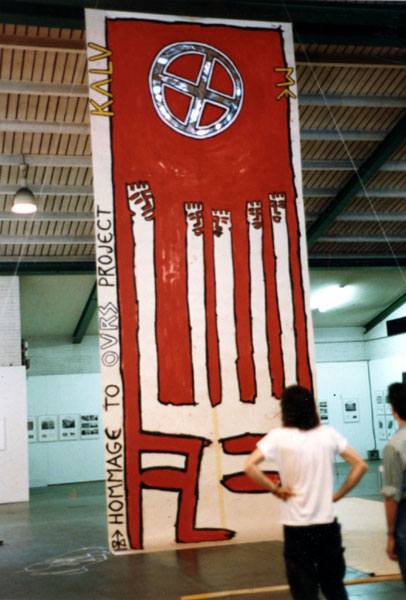
Figure 9. OURS-Artist Laurent Possa at Art 19 Basel art fair, 1988
Artists are also invited to present ideas which may be integrated into the actual sculptures, a concept which is already laying the groundwork for the OURS to be co-created for the year 2000. Artists have also been asked to accept responsibility for the project and several projects have been initiated for independent OURS exhibits organized by the participating artists. To date, the OURS Artists represent 8 countries on three continents.
5.4 Participation of the Aerospace Community.
A space sculpture project could not be successful without the collaboration and help of space scientists and engineers. Since 1986, the project has benefited from technical advice concerning space structures technology. Requested information from astronomers and other scientists has been generally easily obtained. The project has often been invited to participate and exhibit in space technology exhibitions and forums (Woods, 1989).
One of the goals of the project is to become a laboratory for space art research in relation to design, development and realization of the OURS sculptures. An international center of operations is envisioned which will offer artists, scientists and engineers from around the world direct hands-on experience.
5.4 OURS for Our Children.
Children can participate in the project by making a drawing about any aspect of the project and exchanging it for a “Piece of the Ring”. The drawings are displayed as a part of the OURS exhibitions and plans are being made to exchange the drawings between children in different countries. For each drawing a donation is made from the project’s funds to a specific charity dedicated to helping less fortunate children in the world. Working with the World Runners Foundation of Switzerland, the OURS project has made contributions to the ORT – Oral Re-hydration Therapy program administered by
UNICEF. This program offers a simple and effective treatment for an affliction that is responsible for over 5 million child deaths per year in the third world.
The OURS art has been sold to aid efforts that are working to end world hunger. The first public exhibit of the OURS Project raised more than $1,500 (2,200 Sfr.) for the Hunger Project. These activities are linking the realization of the sculptures with actually helping the world.
5.5 Business Participation.
The OURS Project is actively seeking the cooperation and participation of businesses that can identify with the spirit and the message of the OURS space sculptures, participation can be in the form of financial support, and/or company specific materials, services or products which may further the project. Businesses may become either partners or patrons
Partner and patron businesses benefit through company identification with a humanitarian global and cultural event as well as through the public use of their products and services in the development of the project. The OURS project acknowledges these contributions in its publications and during its exhibitions. Each business also receives an art work made by one of the OURS artists. Company logos will not go on the OURS sculptures.
Businesses wishing to link their participation with the project’s success may become patrons with a specified financial contribution. Patrons are given the right to publicize their participation in the project.
5.6 Television.
It has been planned that the deployment of the OUR-SPS will be video recorded and transmitted from space and broadcast to the world audience. It is hoped that this broadcast will be received world-wide. To assist in raising funds for the project television rights to document the project in greater detail will be negotiated with interested broadcast companies.
6. PROJECT ORGANIZATION.
6.1 Project History and Activities.
The OURS Project was launched in 1984 with the goal of creating a context for the OURS for the year 2000. The project was introduced to the international aerospace community in June of 1986 at the SPACE COMMERCE’86 – a bi-annual conference and exhibition on the industrial uses of space held in Montreux, Switzerland. In 1987 it was presented to art world for the first time at the annual international Basel art fair ART 18 1987 (also in 1988 & 1989) which is held in Basel, Switzerland. Regular exhibitions and presentations have taken place in 7 countries. Over 100 press articles, stories and news items have appeared in the international media.
6.2 The OURS Foundation.
To insure that the integrity of the OURS Project is maintained, a non-profit OURS Foundation, headquartered in Switzerland is being incorporated to administer the project and to be the repository of its concept and funds. The OURS Foundation will have the authority to sign contracts and enter into business relationships. Under Swiss law the finances of the foundation will be audited by federal officials on a yearly basis. If for any reason the foundation cannot continue its activities, the money in its accounts will go to charity. Its charter states:
“The primary purpose of the OURS Foundation is to place a global art work in orbit around Earth as a visible sign of planetary unity, wholeness and peace. This sign will symbolize the relationship between humanity and the rest of nature. With this idealistic and cultural use of space we wish to focus the human spirit toward creating a more positive and responsible future for our planet. To realize this purpose the OURS Foundation is accepting contributions of all forms from the entire world. In addition, the OURS Foundation is obliged to support humanitarian, environmental, educational and cultural projects and programs within the framework of its means. “
6.3 The OURS Society.
To serve the needs of the membership of the project an OURS Society has been formulated. The main purpose of the OURS Society is to further the goals of the OURS project in an active manner. This includes active participation in the actual realization of the project through meetings, the newsletter, engineering, art works, exhibits and presentations. Membership is a way for anyone to take personal responsibility for the project as well as an active role in its development.
The OURS Society is also a means to create chapters in other countries. Furthermore, the organization will seek to establish cooperative relationships with other organizations that share its interests and with those which are working toward creating a healthier and safer planet.
7. CONCLUSION – A Minute for Peace.
Though it has never been a goal of the OURS Project to try to be the first to deploy an art work in outer space, this opportunity may now be at hand with the realization of one or more OUR-Space Peace Sculptures in the year 1992. If circumstances prevail and the OURS Project does end up with this honor, it is hoped that they will help set a responsible precedent for this form of global communication. Seeing them floating in space with our home planet in the background will be truly exciting.
The emergence of a planetary civilization and a global culture are essential ingredients of any future “human space program”. The OURS Project represents a global art concept – both in terms of shared experience and in co-creation. As such, it may be an example of the kind of activity and thinking necessary for our civilization to survive, thrive and eventually leave this planet. Seen in this light, the process of making the OURS sculptures a reality may ultimately be more important than their eventual realization as objects.
Nuclear weapons are obsolete – using them would be suicide. Yet they are there poised on tips of rockets and aimed at our future. Each new weapon system is a drain on vital programs needed to restore the environment and to meet other desperate human needs. The cost of manufacturing and deploying two OUR-Space Peace Sculptures during the International Space Year will be approximately $1.9 million. This amount, as noted earlier, is just one minute of our current global military expenditures. With this perspective in mind, these sculptures with their message of – “Peace on Earth and Peace with Earth” – are being offered to our planet as inexpensive and innovative additions to our global strategies for maintaining world peace and preserving the environment.
And when the OUR-Space Peace Sculptures eventually do orbit our Earth, will they make a difference? Will they stop the production of one more nuclear bomb? Will they convince one legislature to vote against more armaments? Will they prevent one tree from being felled in the tropical rainforest or prevent the extinction of just one species? Perhaps not, but if they cause people in every country to pause for just one minute to consider their personal role in the “War with the Earth’ then they will have been worth the effort and the cost.
Humankind has indeed arrived on the threshold of the greatest age in its history. The universe is calling us – the cosmos is ours to explore and to enjoy, but only if we as individuals and we as a species make peace with each other and peace with our planet. Only then will our civilization have passed the cosmic test by having made the cosmic choice in favor of life. Hopefully the OUR – Space Peace Sculptures will one day symbolize and celebrate that that choice is being made.
ACKNOWLEDGEMENTS
The authors of this paper would like to acknowledge Mr. Joe Caruso and Mr. Andres Obrero for their computer graphics. Mr. Hans Peter Habegger for striving to make us solvent, Mrs. Adelheid Woods for her dedication, proofreading and patience, Dr. Elisabeth Stern, for her encouragement, Mr. Lawrence Thomas, NASA Technical Liaison Officer – GAS program, for the information and assistance he supplied and Evgeny Luppov, contract officer at V/O Licensintorg, for his interpreting. Special thanks go to Mrs. S. Guerra, director of ATARI (Switzerland) Ag for the computer and desk top publishing equipment on which this paper was written and to Mr. A. Aebi and Natural AG for the contribution to our travel expenses. We would also like to acknowledge Mr. Frank White, the author of the book The Overview Effect, both for his important book and for his unpublished comments and insights into the “human space program”, we wish to especially acknowledge all of our OURS supporters and participants and particularly – the children and the artists that have answered our call. “Ad Astra”
REFERENCES
- Bernasconi, M.C. (1988), “Initial Design concepts and Parameters for the O.U.R.S. System” Technical Documentary Report, Thomas Jefferson Assoc. Vezia. Switzerland, January 1988.
- Bernasconi, M.C. and Reibaldi G.G. (1985), “Inflatable. Space Rigidized Structures: Overview of Their Applications and Technology impact.” Paper IAF-85-210 presented at the 36th IAF Congress. Stockholm, 7-12 October.
- Bernasconi, M.C., Pagana. E and Reibaldi, G.G. (1987),“Large Inflatable, Space-Rigidized Antenna Reflectors: Land Mobile Services Development”, Paper IAF- 87-315 presented at 38th IAF Congress, Brighton (UK), October 10-17.
- Bernasconi, M.C. and Kose s. (1988), “The Space-Rigidized Thermal Shield for the ESA Far-Infrared Space Telescope (FIRST)”, Paper presented at the 3rd European Symposium on Space Thermal Control and Life Support Systems, Noordwijk (NL), October 3-6; also: ESA SP-288, pp. 165-173.
- Fincn, E.R. Jr., (1984) “Magna Charta of Outer space for All Nations”, Acta Astronautica. Vol. 11, No. 6. pp 337, 1984.
- Mendell, W.W. and Kessler. D.J., (1987), “Limits to Growth in Low Earth Orbit”, Paper IAA-87-574 presented at 38th IAF Congress, Brighton, (UK), October 11-16.
- Read, H. (1967), The Meaning of Art. Farber & Farber. London, 1967 pp. 262-268.
- Sivard. R. (1986, 1988), AssPress “Per Minute: 1.6 Million Dollars for Defense”, December 9. 1986
- “Gigantic Sums for Defense” January 13, 1988, Tages Anzeiger. Zurich. Switzerland.
- Taylor, R.L.S. (1986), “Beyond Space Telescope”, Article published in SPACE, Vol. 2 No. 1. March-May 1986, pp. 22-28.
- White, F. (1987), The Overview Effect: Space Exploration and Human Evolution, Houghton Mifflin Company, Boston, 1987.
- Woods, A. R., (1987), “Orbiting Unification Ring Satellite”, project description included in Spirit of Enterprise ; The 1987 Rolex Awards, Van Nostrand Reinhold (UK), 1987, pp. 184-186.
- Woods, A. R., (1989), “Orbiting Unification Ring Satellite Project” paper presented to the “Many Roads To Space” session – 8th Space Development Conference. Chicago. May 26-29.

